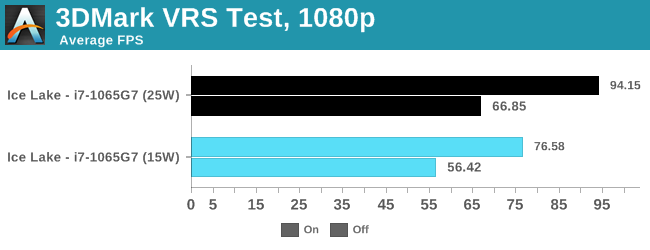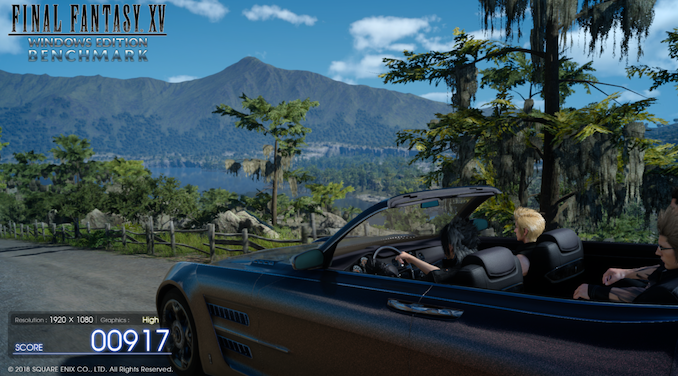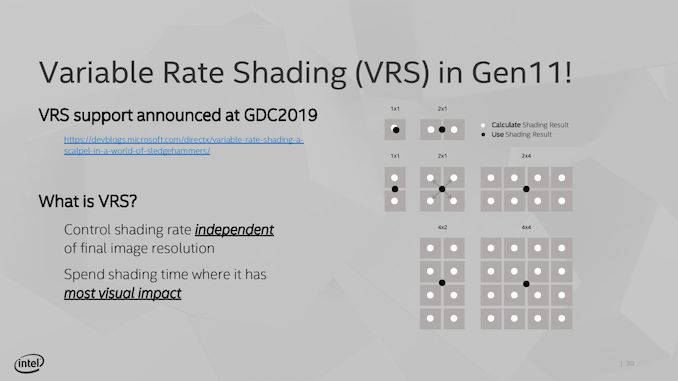The Ice Lake Benchmark Preview: Inside Intel's 10nm
by Dr. Ian Cutress on August 1, 2019 9:00 AM EST- Posted in
- CPUs
- Intel
- GPUs
- 10nm
- Core
- Ice Lake
- Cannon Lake
- Sunny Cove
- 10th Gen Core
Gaming Results (15W and 25W)
One of the biggest changes to the Ice Lake design is in the integrated graphics – Intel is now giving more focus and more die area to graphics, something it has arguably been neglecting for several years now. With Ice Lake, we move to a Gen11 graphics architecture, which is almost like the previous Gen9.5 but now with added support for variable rate shading (VRS), moving from 24 EUs to 64 EUs, and memory support up from LPDDR3-2133 to LPDDR4X-3733.


World of Tanks is a very CPU driven benchmark, and having the extra frequency of the 25W processor does help here. We're getting a sizeable uplift from Whiskey Lake, due to the extra EUs and memory frequency.


Our Final Fantasy test seemed to regress in 25W mode, although still within the noise. This test is still GPU bound, so adding the extra TDP to the CPU didn't actually help much. However, comparing to the Whiskey Lake integrated graphics, we've got over a 2x speedup.


Similarly with Civilization, with what is normally our 'IGP' settings, we are still GPU limited here.
One of Intel's newest features is Variable Rate Shading.
If developers add the option, soon to be an easy checkbox in Unity and Unreal, the game can decide to control the rate at which it shades pixels, from calculating every pixel down using one result across a 4x4 grid, to save compute power. Currently the only way to test this is with the 3DMark functional demo.

The new VRS test in 3DMark is designed as a feature test to show the potential uplift effect from enabling variable rate shading within a game. In both 15W and 25W modes, the data saw a good uplift, and we seemed to get more out of the 25W mode than the 15W mode.














261 Comments
View All Comments
CharonPDX - Saturday, August 3, 2019 - link
Wow. 0.7 GHz? AKA 733 MHz? Like the Celeron I had back in 2000? (That overclocked like a *BOSS*, just crank the FSB up from 66 MHz to 100 MHz, and get 1.1 GHz.)AV_Stables - Sunday, August 4, 2019 - link
The best OC CPU Intel ever released was the Celeron 300A (had that at 598mhz) :) almost 100% OC, moved on to Pentium 3 Coppermine & Tulatin and an ES (clocked at 733) using the 920C (rambus) chipset (horror absolute) . But coming back to earth and reality this preview is just A PR exercise in customer retention. Sure the iGPU and cores are better, but come on people are you this easily won over. The Y series is more power hungry. Id rather you stick to actual released products, as many will see this as doing Intels' PR work for them as I do.voicequal - Sunday, August 4, 2019 - link
Given that the CPU is already starting to ship to OEMs, better to have hard facts and analysis from a trusted source than weeks more of rumor and speculation while we wait for an arbitrary public release date.AV_Stables - Monday, August 5, 2019 - link
Show me one in the wild and ill say fair do.guachi - Saturday, August 3, 2019 - link
Appreciate the preview. YouTube channel Hardware Unboxed highlighted your preview and made sure to tell viewers to come here and give you guys the views.As I'm a regular reader, I'm happy to do so.
albert89 - Saturday, August 3, 2019 - link
Is it really, really, really happening this time around ?HarryVoyager - Sunday, August 4, 2019 - link
It's probably already been asked an answered, and I've missed it in the thread or review, but how do we think these are likely to stack up against the current AMD CPUs for single thread performance? I noticed that they appear to have increased the per clock performance, but appear to have had to drop the clock rate to get that.The thing that's eating my PC's lunch is primarily VR flight simulators (Tomcat Tomcat Tomcat!), and I'm expecting the main ones are going to remain single thread performance dependent for the next 5 years or so.
Basically, if it stays in the 5%-10% range, and I'm still able to put together a machine that can do 45+ fps with a Ryzen 3000, then it make more sense to take that hit, but if we're looking at a 15-20% effective difference, then the Intel option becomes more meaningful.
I just wish the Il-2 or DCS teams would put together a good benchmarking tool...
Haawser - Sunday, August 4, 2019 - link
These are low power mobile chips, not desktop CPUs.voicequal - Sunday, August 4, 2019 - link
This Ice Lake part is targeted at mobile. If you need guaranteed single thread performance, you'd be better off with a desktop part that clocks higher and can operate at max frequency for an indefinite time without running into thermal or power budget limits.https://www.anandtech.com/show/14664/testing-intel...
This page show direct comparison with Ryzen 3900X, but it's only synthetics and doesn't normalize for frequency differences between the CPUs. That will surely come later in the full review.
Pizdatron - Monday, August 5, 2019 - link
Where are the 95W etc... variance , no info on that